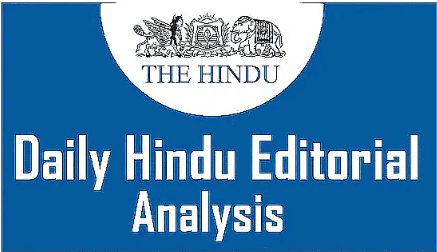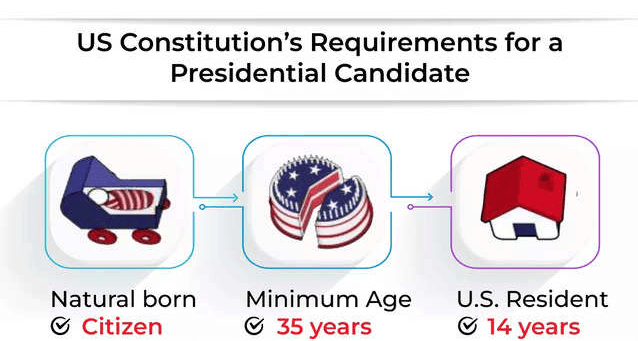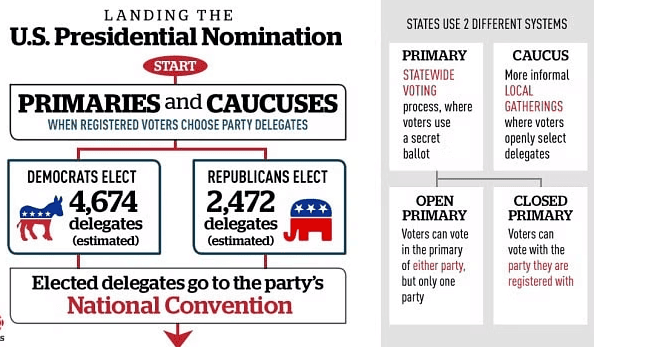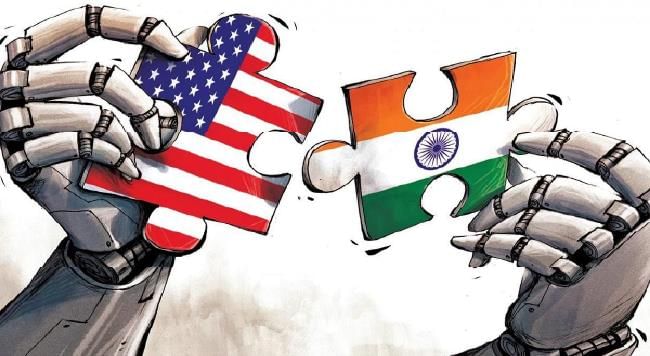The Hindu Editorial Analysis- 7th November 2024 | Current Affairs & Hindu Analysis: Daily, Weekly & Monthly - UPSC PDF Download

In America, surviving the messiah , Rein in the darkness , A West Asia under Donald Trump
Why in News?
America has spoken. The 2024 United States presidential election has delivered an outcome that, once again, belied the polls, which, until the day before the results came, insisted that the prospects of the two candidates in the fray, Republican and former U.S. President Donald Trump and Democrat and current Vice-President Kamala Harris, were poised on a razor’s edge. Instead, November 5 turned out to be a day of reckoning for the Democratic Party, as it watched one swing State after another slip out of its grasp and tip the election map of the country into deep red territory.
The US has had an elected president since its constitution went into effect in 1789. Unlike in many countries, the Presidential election in the US is rather a year-long process starting from announcing of candidacy to the Inauguration day.
U.S. Constitutional Requirements for Presidential Candidates
- The President must:
- Be a natural-born citizen of the United States
- Be at least 35 years old
- Have lived in the United States for 14 years
- These age and residency rules must be met by Inauguration Day.
- Anyone who meets these conditions can announce their intention to run for President at any time.
- The Vice-President must also fulfill all the same qualifications required of the President.
- In India, a President can also be a naturalized citizen.
- A candidate for the presidency in India needs 50 electors to propose and 50 electors to second their nomination for it to be on the ballot.
- In the United States, a person can serve as President for only two terms, while in India, there is no such limit.
A two-party system
- Although the constitution allows for many political parties, the current political scene is mainly influenced by two major parties.
- The two main parties are the Democratic Party and the Republican Party.
- There are also several third parties that operate in the U.S., which occasionally win local elections.
- Since the 1980s, the largest third party has been the Libertarian Party.
Nomination process – Primaries and Caucuses
- Many candidates from each political party announce their intention to run for president more than a year before Election Day.
- For example, Bernie Sanders and Hillary Clinton declared their candidacies for the Democratic Party, while Ted Cruz and Donald Trump did so for the Republican Party.
- Each party then selects one candidate through a nominating process, which is longer and more democratic compared to the process in India, where party leaders choose the Prime Minister candidate.
- The nominating process consists of two main parts:
- A series of presidential primary elections and caucuses in each state.
- Presidential nominating conventions held by each party.
- To become a party's presidential candidate, a nominee must secure a simple majority of delegates on the day of the convention.
- Each political party decides how many delegates to assign to each state and territory.
- A delegate is a person chosen by the public in each state to vote on their behalf for the nominee. Delegates are selected through primaries and caucuses.
- Primary elections are organized by state and local governments where party members vote in secret for their preferred candidates.
- Caucuses are private meetings held by political parties, where participants form groups based on their chosen candidates. Each group gives speeches to support their candidate and tries to convince others to join them.
- After the primaries and caucuses in each state, the number of delegates for that state is distributed among the candidates based on their vote share. For example, if Bernie Sanders wins more than 22% over Hillary Clinton in the New Hampshire primary, he would receive 15 delegates while Clinton would get 9.
- Some states conduct only primary elections, some only caucuses, and others use a mix of both. These events typically occur between January and June before the federal election, with Iowa and New Hampshire traditionally going first for caucus and primary, respectively.
- In the Democratic Party, there are two types of delegates:
- Delegates: These representatives vote based on the popular vote from their states during the convention.
- Super delegates: These are influential figures such as lawmakers, governors, former presidents, and national party officials who can support any candidate they choose, regardless of their state's vote.
- In the Republican Party, delegates are categorized as:
- Pledged delegates: Regular delegates who are committed to vote according to the primary results.
- Unpledged delegates: Similar to super delegates, these include the top party officials from each state and territory who can vote freely on convention day.
- This entire process is aimed at selecting a presidential candidate for each party.
- Unlike the general election, voters in U.S. territories can also elect delegates to the national conventions.
- These delegates choose the party’s presidential candidate on convention day, which usually takes place in July. The selected presidential candidate also picks a vice presidential nominee to run alongside them.
- This system was not part of the U.S. Constitution and has developed over time through the political parties.
Election Process
- Article Two of the United States Constitution set up how presidential elections work, including the Electoral College.
- This system was a compromise between the framers who wanted Congress to choose the president and those who wanted a national popular vote.
- Generally, voters cast their votes on a ballot to pick a candidate. However, this is an indirect election.
- Voters do not directly choose the president; they vote for representatives called "electors". These electors usually commit to voting for certain presidential and vice presidential candidates, similar to delegates in primary elections.
- The number of electors for each state matches the number of Congress members the state has. Currently, there are 538 electors, which includes 435 Representatives and 100 Senators, plus three additional electors from the District of Columbia.
- U.S. territories are not represented in the Electoral College, meaning citizens in those areas cannot vote in the presidential election.
- Most state laws follow a winner-take-all system. In this system, all of a state's electors go to the candidate who gets the most votes, rather than splitting the electors based on the vote percentage.
- This can result in a situation where a candidate wins the election without receiving the most popular votes. For example, in 2000, George W. Bush won the presidency even though he lost the popular vote to Al Gore.
Election Day
- An election for the President of the United States takes place every four years on Election Day, which is the first Tuesday after the first Monday in November. The next presidential election will be on November 8, 2016.
- In the Presidential system, there is a clear separation between the executive and the legislature, unlike in a parliamentary system.
- The executive branch does not answer to the legislature, meaning the government does not collapse if it loses majority support.
- If the president position becomes vacant, there is no need for a new election; the vice president steps in and continues the term.
- Because of this structure, election dates are set and can occur alongside other elections, such as for the House of Representatives, Senate, Governors, and State legislatures.
- This system is difficult to implement in countries like India, where discussions about holding simultaneous elections to the Parliament and State Assemblies face challenges, as there is no assurance that a government can complete its term.
- Why is Election Day on a Tuesday in November?
- In the past, when people traveled to vote by horse, Tuesday was convenient. It allowed time for worship on Sunday, travel to the polling place on Monday, and voting on Tuesday, all before market day on Wednesday.
- November was chosen because it falls between the end of the harvest season and the start of winter weather.
- Inauguration Day
- In December, the winning electors from each state gather at their state capitals to cast their electoral votes for President.
- Although electors can technically vote for anyone, 24 states have laws that penalize those who do not vote for the candidate they pledged to support.
- In early January, the votes are tallied by the incoming Congress.
- If no candidate gets a majority of the electoral votes (currently at least 270), the House of Representatives will decide who becomes President.
- The President-elect officially takes office on Inauguration Day, which is January 20.
- Related Terms
- Super PACs are independent political groups that can support a candidate with unlimited donations from individuals, unions, or companies. They cannot give money directly to a candidate but can run positive ads for them or negative ads against their opponents. Many ads from super PACs are negative and often stretch the truth.
- Super Tuesday refers to a day when numerous U.S. states hold their primaries and caucuses, making it the day with the most delegates available for the Democratic and Republican parties.
- The Tea Party movement is known for its conservative views and influence within the Republican Party. Members advocate for reducing the U.S. national debt and federal budget deficit by cutting government spending and lowering taxes. They oppose government-funded universal healthcare and represent a mix of libertarian, populist, and conservative activism.
India-US Relations: Evolution
- During the Cold War, India chose to remain non-aligned, while the United States developed closer relations with Pakistan.
- After the Cold War ended, India and the US started to strengthen their diplomatic relationship.
- The US-India Civil Nuclear Agreement in 2005 was a significant step in building a strategic partnership.
- Key agreements that laid the foundation for this partnership include:
- LEMOA (Logistics Exchange Memorandum of Agreement)
- COMCASA (Communications Compatibility and Security Agreement)
- BECA (Basic Exchange and Cooperation Agreement for Geospatial Cooperation)
- GSOMIA (General Security of Military Information Agreement)
Significance of India-US Relations
- Economic Growth: Strong connections between countries boost trade and investment, leading to the creation of jobs and economic progress in both nations. In 2023, the U.S. is India's second largest trading partner. The trade between the two countries has increased by 72% from 2017-18 to 2022-23.
- Defense Collaboration: Important defense agreements like LEMOA and COMCASA enhance military cooperation and coordination. For example, joint military exercises such as Yudh Abhyas take place to strengthen these ties.
- Technological Partnership: Working together on essential technologies improves innovation and competitiveness. An example of this is the India–U.S. Initiative on Critical and Emerging Technology (ICET).
- Cultural Exchange: A lively Indian diaspora and educational exchanges help improve cultural relationships and understanding between the two societies. For instance, more than 200,000 Indian students are studying in the U.S.
- Quad Alliance: The Quadrilateral Security Dialogue (Quad) promotes cooperation for regional security, tackling issues in the Indo-Pacific, and supporting democratic values. An example of their efforts includes initiatives in vaccine distribution and maritime security.
- Climate Cooperation: Collaborative actions to combat climate change enhance global environmental governance and support sustainable development initiatives. A notable example is the clean energy partnership between the U.S. and India.
India-US Defence Relations
- 2005: Strategic talks began, indicating a stronger relationship between India and the US.
- 2016: The US recognized India as a “Major Defense Partner,” which improved access to advanced technologies and cooperation.
- 2016-2018:Several important agreements were signed between the US and India:
- LEMOA (Logistics Exchange Memorandum of Agreement): This agreement allows both countries to support each other's logistics.
- COMCASA (Communications Compatibility and Security Agreement): This agreement ensures secure communication between the Indian and US militaries to work together effectively.
- BECA (Basic Exchange and Cooperation Agreement): This agreement enables sharing of geospatial intelligence, improving military accuracy and navigation.
- GSOMIA (General Security of Military Information Agreement): This protects the sharing of classified information and promotes intelligence cooperation.
- 2018: India was granted Strategic Trade Authorization Tier 1 (STA-1) status, making it easier to access US military technology.
- 2018: The 2+2 Ministerial Dialogue was created to strengthen strategic cooperation.
- 2019: The first joint military exercise, “Tiger Triumph,” took place, and the Industrial Security Annex (ISA) was signed to aid US companies in Indian defense production.
- 2020: The Initiative on Critical and Emerging Technology (iCET) was launched to enhance collaboration in artificial intelligence, quantum computing, and cybersecurity.
- 2021: The Maritime Information Sharing Technical Arrangement (MISTA) was established to improve awareness of maritime activities.
- 2021-2022: Advancements were made in significant equipment deals, including MQ-9B Sky Guardian drones and F-414 fighter jet engines.
- 2023: The India-US Defense Acceleration Ecosystem (INDUS-X) was launched under iCET to encourage collaboration among defense firms, investors, and research institutions.
Upcoming Initiatives and Anticipated Developments
- Security of Supply Arrangement (SOSA): Aims to ensure a dependable and safe supply of defense equipment and technology. Ongoing discussions are focused on strengthening the resilience of the supply chain.
- Reciprocal Defense Procurement Arrangement (RDP): Designed to make defense procurement processes smoother and to expand market opportunities for Indian manufacturers, thereby enhancing the efficiency of purchasing.
- Joint Production of Stryker Armoured Combat Vehicles: Intended to improve collaborative defense capabilities between the parties involved.
- Enhanced Public-Private Collaborations: Aims to create incubator centers, establish joint innovation funds, and provide support for startups through the Defense Advanced Research Projects Agency (DARPA) and the Defense Innovation Unit (DIU).
- Streamlined Regulatory Reforms: Focuses on simplifying and speeding up regulations related to defense exports and technology transfers. It seeks to address the complexities of the International Traffic in Arms Regulations (ITAR) and Export Administration Regulations (EAR), as well as improve STA-1 exemptions to facilitate smoother transactions.
Challenges in India-US Relations
- Trade Imbalances create tension and impact areas such as agriculture and manufacturing. The U.S. has raised concerns about India's tariffs on farm products, leading to trade disagreements.
- Data Privacy Concerns: There are different methods for protecting data and managing data that crosses borders. The U.S. wants data to flow freely, while India focuses on keeping data within its own borders for privacy reasons.
- Defense Procurement Hurdles: Bureaucratic delays and differences in opinion slow down defense partnerships. For example, the agreement on the Predator drone deal has been delayed.
- Visa Restrictions: The U.S. has tightened visa rules, especially for H1-B visas, which limits the movement of Indian IT professionals and affects the technology sector.
- Intellectual Property (IP) Rights: There are conflicts over how to protect intellectual property, especially in the pharmaceutical industry, which affects trade talks.
- Geopolitical Differences: Different perspectives on countries like Russia and Iran, along with other regional issues, can sometimes make it hard for the two countries to cooperate strategically.
Way Forward
- Resolving trade disputes will help improve economic relationships between countries. For instance, negotiating lower tariffs on steel and aluminum imports can lead to better trade advantages for both nations.
- Improving tech collaboration involves setting similar data privacy standards and increasing cooperation on cybersecurity. An example is the creation of a US-India Cybersecurity Forum.
- Simplifying defense procurement processes and speeding up technology transfers will boost defense partnerships. A good example is the Defense Technology and Trade Initiative (DTTI), which aims to fast-track projects like the Joint Advanced Tactical Ground Station (JATGS).
- Relaxing H1-B visa restrictions will benefit the technology sectors and professional exchanges in both countries.
- Enhancing intellectual property (IP) discussions through diplomatic means will promote trade benefits. For example, establishing an India-US IP Working Group.
- Boosting ICET cooperation by strengthening the India–U.S. Initiative on Critical and Emerging Technologies (ICET) will encourage collaboration in advanced technology areas.
- Regional diplomacy is key, as it involves better coordination on geopolitical challenges such as Indo-Pacific security and terrorism, which will help achieve shared strategic objectives.
|
38 videos|5288 docs|1117 tests
|
















